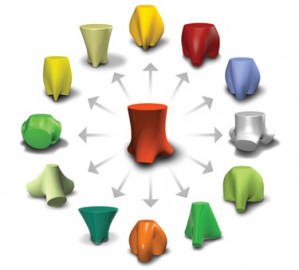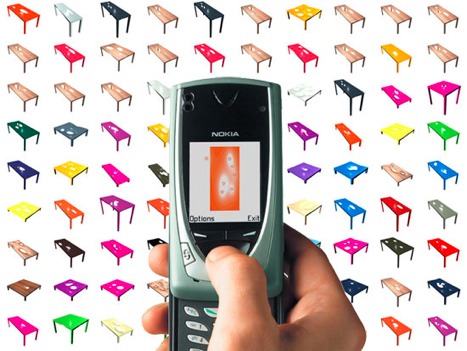What happens when everyone is a maker?
By Randall S. Newton
For years, those of us who are paid to cover engineering technology were sometimes accused of nodding off. There just wasn’t a lot of innovation going on. Whether we were looking at simulation, 3D modeling, or 3D printing, it seems at times covering the industry was synonymous with watching paint dry. 
What has changed? The incredible speed increases in basic computation—and the rise in general purpose graphics processing units—in the last five years are the obvious foundation driving engineering IT today. Ideas that were shelved as being “too computationally intense” are now seeing the light of day.
In 3D product development, the whole movement of bending design history with such tools as SpaceClaim, Siemens PLM’s synchronous technology, Autodesk Inventor Fusion and others were not possible a few years ago. In AEC even the laggards are starting to talk about the necessity of building information modeling. Digital content creation is using the algorithms of product simulation to make animations real-world accurate. Access to terabytes in the cloud offer more More MORE.
In 3D printing, the revolution has more than one foundation. As we wrote before, (see “Shapeways seeks to lead personal manufacturing revolution.”), there are three keys to the current excitement in 3D printing:
- Software tools had to reach the point they were usable by average people, not professionals
- 3D printing had to come down in price and up in variety of available materials
- Access to a Maker-esque ecosystem of ideas, services, and markets via the Internet.
But there is one more rather important element, the rise of the 3D-literate consumer.
The younger generation is IT literate in ways their elders find mind-boggling. It is not unusual for a teen to chat with a friend face-to-face while tapping a text message on a cell phone keypad to another friend at the same time, not missing a beat in either conversation. They expect WiFi everywhere, and use 3G/4G without a thought as to what a marvel it is to have data retrieval in a pocket-size product. Texting, Yelp, Facebook, Foursquare, Twitter and the like are the communication channels of the present for these kids, not the future.
These same users are more 3D aware than any previous generation. Xbox, PlayStation, even cell phones are all 3D-based interaction devices. Agreed, much of the interaction is about shooting aliens. 3D movies are no longer a joke (well, most of them). Then there?s Second Life, the 3D avatar social networking service we heard so much about a few years ago. It hasn’t gone away, but is more richer and nuanced than ever.
Whatever the technology, now and in the future, 3D awareness will only be more prevalent. Soon there will be no need to train designers, engineers, and manufacturers the art of creating or interpreting abstract and ambiguous orthogonal views from 2D drawings. There will be a new generation of professional user, with levels of expectation for user experience for any software that is so in advance of what ?the industry? currently offers, that software companies will be challenged to keep up. Users want rich, realistic, and holistic data that represents the reality, whether that is in terms of form, function, aesthetics or manufacturing-related information. Think the 3D master model is the thing now? We ain?t seen nothing yet.
Print Your Product
The push is for richer 3D environments everywhere in product development. Look at the advances in the additive fabrication/3D printing market and you have devices that can in some instances produce end-use components direct from the computer-based model. No need to invest in a static, non-flexible manufacturing production infrastructure. The range of products that can be produced, as a printed product will only increase.
 The days of the unusable, fragile and brittle resin-based RP models are quickly disappearing. Laser sintering, while I?m sure is not the killer app, provides a means with which you can build functional parts using functional materials, either plastic or metal. So, coming sooner than you can adjust, you?ll have a larger proportion of the population not only 3D literate but armed with a manufacturing capability to produce whatever they want. There?s one catch: Just being able to manipulate 3D data on screen doesn?t make you a good designer.
The days of the unusable, fragile and brittle resin-based RP models are quickly disappearing. Laser sintering, while I?m sure is not the killer app, provides a means with which you can build functional parts using functional materials, either plastic or metal. So, coming sooner than you can adjust, you?ll have a larger proportion of the population not only 3D literate but armed with a manufacturing capability to produce whatever they want. There?s one catch: Just being able to manipulate 3D data on screen doesn?t make you a good designer.
Herein lies the future of engineering software, placing the skills and knowledge of product development into the hands of the mass-market consumer. The average person—lacking design skills, confidence, and infrastructure to create a product— nonetheless wants the ability to customize a product the way teens “skin” their cell phone screens or Facebook pages today. Millions will gladly pay extra for a product if they can work it over in “MyDesignSpace” and then have it arrive on their doorstep in two days. Technologies like the functional design tools within CATIA and Autodesk Inventor give you the ability to define the function of a part (plastics in particular) long before you define the external form.
Technologies like knowledge-based or rule-based design offer the same—essentially the ability to define product variance within specific rules, but combined, allow the 3D-aware user to manipulate a product to their needs, not just configuration of a base product, but something more fundamentally different. If you look at a lot of products, particularly in the consumer space, the internals are all standard. The PCB?s, displays, the mechanical/electronic interaction features (mounting boss)—these are all standard. What changes is the external. It will become possible to create products that the user adapts to their needs (or whims) through a web-based front-end and quickly have the internal interface features update to match.
The externals could then be built on a EOS INT-P machine in China. An employee on-site would snap in the internals according to the spec (perhaps located and displayed on screen above the workstation by scanning an RFID tag linking the physical part to the originating 3D CAD data and customer requirements). The whole thing could be shipped within 48 hours.
There is nothing futuristic about the workflow described above. It is currently used in the creation of customised hearing aids—in huge volumes. The majority of consumers will always buy an off-the-shelf product; lower cost and traditional manufacturing methods aren?t going to disappear. But for high-value goods and those where personalization rises to a point where value is sufficient, the possibilities are truly exciting. We all have products that we use day in and day out that we?d like to change, even in the smallest of ways. What will change is that we will have the ability to define those products and to make design modifications—albeit still within limits—ending with products that are more personal in utility as well as style.
Of course, there?s the problem of resources. If you have the general public ?designing? products themselves, the value attached to those products is initially high. The facts are that designers have a skill in providing a product, which suits many and integrates those requirements into a single or a short range of product. By opening the design mod floodgates to everyone, you have the potential to create products with a very short lifecycle. That means one thing—a lot of scrap. There could well be redundant waste and horrendous recycling, repurposing problems in the short run. But once people get over the initial thrill, perhaps we are really headed for an era of true mass customization.
IT writer Dan Stanwick contributed to this article.





